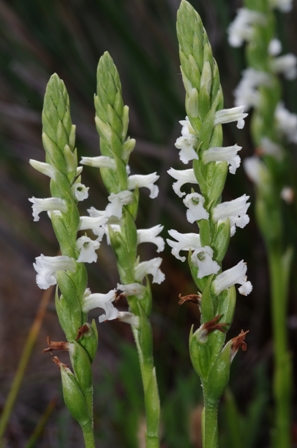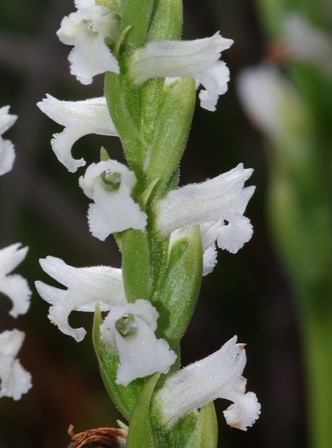Spiranthes aestivalis - Summer Lady's-tresses
Phylum: Magnoliophyta - Class: Liliopsida - Order: Orchidales - Family: Orchidaceae

This orchid is now extinct in the UK due to habitat destruction. It was last recorded in Britain in 1952 and had been clinging onto survival in a few spots including the New Forest in Hampshire and the Channel Islands. Land drainage for agricultural purposes and collection seem to have been the main culprits for its demise.
Description
Although this orchid can grow up to 40cm smaller plants (up to 20cm) are more common. There are 3 - 6 leaves at the base of the stem with a few smaller bract-like leaves higher up. The stems can be yellowish in colour and have fine hairs towards the top. Each infloresence carries up to 20 pure white, hairy flowers which are funnel-shaped and wrapped around the stem in a spiral.
Sometimes confused with Autum Lady's-tresses Spiranthes spiralis, it is the flowering times which set these two species apart. As its name suggests, Autumn Lady's-tresses flowers late in the year - from August in the UK and well into October in the Mediterranean region. Spiranthes aestivalis comes into flower in July.
Distribution
This orchid is distributed widely throughout Europe but is rare and in steep decline across its entire range. Now extinct in Holland and Belgium it is most at peril in the northern part of its territory. Further east in central Europe and south to the Mediterranean it is still hanging on but only because these countries have been slower to adopt the intensive farming regimes that have long been in place in northern Europe.

Summer Lady's-tresses is in steep decline due to habitat destruction.
Habitat
Spiranthes aestivalis requires humid conditions and grows in boggy land which is alkaline, although some countries report colonies in land with more acidic conditions. Dune slacks which are flooded during winter and retain high levels of moisture throughout the summer are one of the few remaining habitats where this plant survives.
Flowering times
This orchid flowers late in the year throughout its range and is at its best from mid-July to mid August
The specimens on this page were photographed in the Portugal in July. Pictures: Americo Pereira...
Etymology
The genus name Spiranthes means 'spirally-arranged flowers'. The specific epithet aestivalis means 'of summer'.
Reference sources
The Plant List
Sue Parker (2023) Wild Orchids of the Algarve - where, when and how to find them; First Nature e-book (Amazon Kindle format)
Chris Thorogood and Simon Hiscock (2014) Field Guide to the Wildflowers of the Algarve; Kew Publishing
Anne and Simon Harrap (2005) Orchids of Britain and Ireland; A&C Black
Pierre Delforge (2005) Orchids of Europe, North Africa and the Middle East; A&C Black
Please Help Us: If you have found this information interesting and useful, please consider helping to keep First Nature online by making a small donation towards the web hosting and internet costs.
Any donations over and above the essential running costs will help support the conservation work of Plantlife, the Rivers Trust and charitable botanic gardens - as do author royalties and publisher proceeds from books by Pat and Sue.


